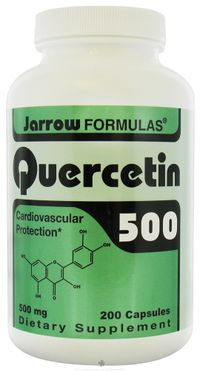Difference between revisions of "Quercetin"
User:Fellrnr (User talk:Fellrnr | contribs) (Created page with "[[File:QuercetinJarrow.jpg|right|thumb|200px|Quercetin as a supplement from [http://go.fellrnr.com/?id=35454X937677&xs=1&xcust=Quercetin&url=http%3A%2F%2Fwww.amazon.com%2FJarr...") |
(No difference)
|
Revision as of 06:51, 24 September 2012

Quercetin is a naturally occurring Flavonoid found in many fruits and vegetables that may improve performance. Quercetin has a long term effect and is generally taken for at least 2-3 weeks rather than immediately before or during exercise. Quercetin is the active ingredient in the FRS range of products, but Quercetin supplements are more cost effective.
Contents
1 Quercetin and Performance
Some studies have shown improvement in V̇O2max and endurance in untrained individuals[1][2] and improved endurance in elite cyclists[3]. However, a number of other studies have shown no improvement [4][5][6][7][8]. These studies have used an average of 1000mg per day (600-2000mg range) for an average of 11 days[9]. Overall, these studies suggest that Quercetin may improve performance of up to 3%[9]. (A 3% improvement would be 5 minutes on a 3 hour marathon, or 7 minutes on a 4 hour marathon.) In addition, it is possible that Quercetin may reduce colds (Upper respiratory tract infections) during training[10].
2 Drug Interactions and Cautions
Quercetin may interact with a large number of drugs including antibiotics and estrogen[11]. It would be prudent to talk to your doctor before taking Quercetin if you are on any medication.
3 Sources of Quercetin
It's hard to get sufficient Quercetin from natural sources. One of the better sources is apples, that provide 4.4mg/100g[12], but that requires you to eat 25Lb (11Kg) of apples per day, which is impractical. The most highly advertised source of Quercetin is from the FRS range of products. These products are convenient, but expensive; getting 1000mg per day would cost $3-5 per day. A more cost effective approach is to take Quercetin as a supplement. For instance Jarrow Quercetin is $12 for 50 days.
4 Mechanism of Action
How does Quercetin work? The leading proposal is that it increases the number of mitochondria which are the parts of the cell that produce energy. This has been shown to occur in animals[13], but so far this has not been replicated in humans. A second proposal is that Quercetin works like Caffeine, but this does not seem to be reasonable given that the effects of Quercetin are not immediate[14]. The level of Quercetin in the blood at the time of testing is not related to the performance improvement[9].
5 Recommendations
There is sufficient evidence to make Quercetin worthy of consideration for those not taking any medications that may have adverse interactions. 1000mg per day, split into two or more doses for at least two weeks seems to be a commonly used approach in studies, but there is nothing to indicate if this is the optimum dose.
6 References
- ↑ Template:cite journal
- ↑ Template:cite journal
- ↑ Template:cite journal
- ↑ Template:cite journal
- ↑ Template:cite journal
- ↑ Template:cite journal
- ↑ Template:cite journal
- ↑ Template:cite journal
- ↑ 9.0 9.1 9.2 Template:cite journal
- ↑ Template:cite journal
- ↑ QUERCETIN: Uses, Side Effects, Interactions and Warnings - WebMD http://www.webmd.com/vitamins-supplements/ingredientmono-294-QUERCETIN.aspx?activeIngredientId=294&activeIngredientName=QUERCETIN
- ↑ USDA Database for the Flavonoid Content of Selected Foods – 2003 http://www.nal.usda.gov/fnic/foodcomp/Data/Flav/flav.pdf
- ↑ Template:cite journal
- ↑ Template:cite journal